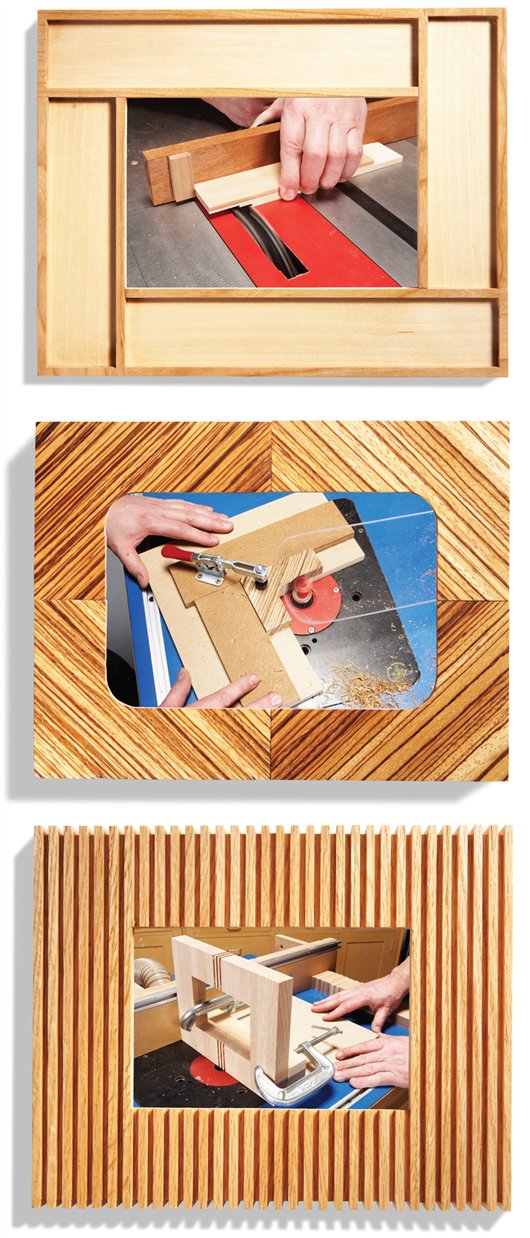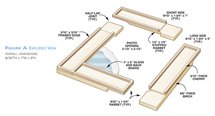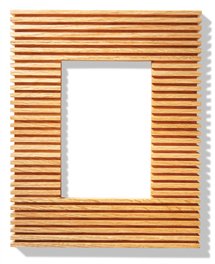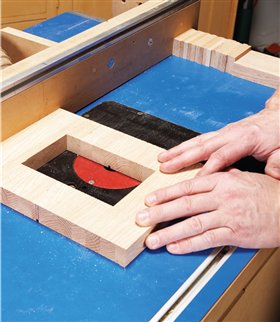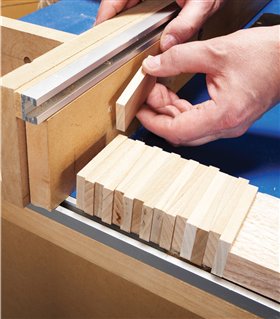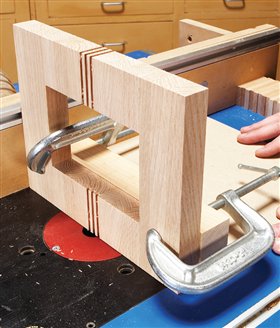Magnetic Frame
Snaps
together
and pulls
apart,
so changing
photos is
easy.

This frame consists of four
identical corner sections
that assemble around the glass,
photo and back board (Fig. D).
Rare earth magnets hold the sections
together. To make this
frame, you’ll need a routing jig
(Fig. E), a pattern and two pieces
of 3/4-in. (or thicker) stock cut to
4-1/16-in. by 4-9/16-in. rectangles.
Build the routing jig first. It’s
used to rout the inside edge of
each piece as well as the grooves
that house the photo assembly.
Use the jig to make the pattern.
Saw a 3-1/16-in. by 4-1/16-in.
piece of 1/2-in. MDF into an Lshape.
Install it in the jig and
rout the inside edges with a 1-
in.-dia. pattern bit (a flush-trim
bit with the bearing mounted
above the cutting flutes).
Use the pattern to lay out the
frame pieces on the two blanks
(Photo 1). Cut the short legs to
length (Photo 2). Then cut the blanks
apart on the bandsaw, install them in
the jig and rout the inside edges
(Photos 3 and 4). Install a 3/16-in.-
wide slot cutter and rout a
1/2-in. deep slot for the photo
assembly (glass, photo and
back board) in each piece
(Photo 5). The photo assembly
provides the frame’s structure,
so it must fit the slot
snugly, but without binding.
Size the slot’s width to fit the
thickness of your photo assembly
(for single-strength glass
and a 1/8-in. back board, the
slot will be slightly less than
1/4-in.-wide).
Fill the slots to fit the photo
assembly (Photo 6). Before
you glue in the strips, assemble
the frame around the
assembly to test the fit. After
gluing, flush each strip with
the end. Then drill centered
holes for the rare-earth magnets
(Photo 7) and install
them flush with the ends—make sure
to orient the magnets’ poles correctly!
Secure the magnets with epoxy.
Fig. D: Exploded View

Fig. E: Jig for Routing Inside Edges

|
|

1. Lay out two corner sections on each
blank. Make sure the grain runs
across the outside corner. If it runs
toward the corner, as on the blank in
the background, the pieces will be
impossible to rout.

2.Cut the short legs to final length
using the miter gauge with a fence
and a stop.
Caution: The blade guard must be
removed for this operation. Be careful!

3. Rout the inside edges with a 1-in.-dia.
pattern bit. Because of the grain’s
direction, you can only rout one leg at
a time. Stop before the bit touches the
adjacent leg or disastrous tearout will
occur.

4. Flip the workpiece over to rout the
other leg. Routing into the corner
can still cause tearout, so complete the
job in stages. Rout a bit, flip the workpiece
and rout a bit more. Then repeat
the process.

5. Rout a centered slot in each piece.
Center the bit by eye. Then make
two passes, one on each face. Rout
halfway, as before, then flip the workpiece.
Once the slot is established, you
can rout against the grain to widen it.

6. Reduce the slots’ depth to 3/16-in.
by gluing in fill strips. Leave the
inside corner 1/2-in. deep, to accommodate
the square corners of the glass.

7. Drill holes for the rare earth magnets
using a fence and a stop block.
The fence centers the hole between the
faces; the stop block centers it
between the edges. |



